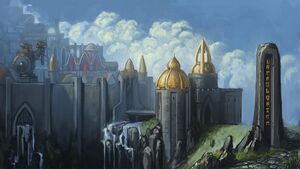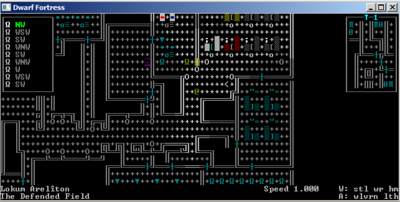- v50 information can now be added to pages in the main namespace. v0.47 information can still be found in the DF2014 namespace. See here for more details on the new versioning policy.
- Use this page to report any issues related to the migration.
Difference between revisions of "Fortress"
| Line 1: | Line 1: | ||
{{Quality|Exceptional|23:25, 20 September 2016 (UTC)}} | {{Quality|Exceptional|23:25, 20 September 2016 (UTC)}} | ||
{{av}} | {{av}} | ||
| − | + | [[File:fortress3.jpg|thumb|A beautifully made fortress.]] | |
:''You may be looking for [[Dwarf fortress mode]].'' | :''You may be looking for [[Dwarf fortress mode]].'' | ||
| Line 7: | Line 7: | ||
== Procedurally generated == | == Procedurally generated == | ||
| − | |||
[[Dwarf|Dwarven]] [[civilization]]s build their fortresses on the edges of [[Mountain|mountain ranges]], and they will act as the seat of power of a dwarven civilization's leaders. They occupy only 3×3 local tiles, while [[hillock]]s and [[mountain halls|halls]] claim much more territory. | [[Dwarf|Dwarven]] [[civilization]]s build their fortresses on the edges of [[Mountain|mountain ranges]], and they will act as the seat of power of a dwarven civilization's leaders. They occupy only 3×3 local tiles, while [[hillock]]s and [[mountain halls|halls]] claim much more territory. | ||
Revision as of 21:13, 12 February 2022
v50.14 · v0.47.05 This article is about the current version of DF.Note that some content may still need to be updated. |
- You may be looking for Dwarf fortress mode.
Dwarves live in fortresses an underground complexes with all the required buildings for dwarven living. In Dwarf fortress mode, the player expedition team embarks in order to construct and operate a fortress. See Quickstart guide for guide on how to establish and maintain your very first dwarf fortress.
Procedurally generated
Dwarven civilizations build their fortresses on the edges of mountain ranges, and they will act as the seat of power of a dwarven civilization's leaders. They occupy only 3×3 local tiles, while hillocks and halls claim much more territory.
Your adventurer can visit dwarven fortresses Ω in adventure mode. They consist of a large rectangular structure made out of stone or metal blocks, with a three-tile-wide entrance on one side. Inside, (it is a roofed structure) there will be a trade depot, possibly with traders from other civilizations hanging out around it. There will also be a two-story tavern here, with the rooms for rent on the second floor. In the center of the rectangle will be a large hole with ramps spiraling downwards on the edges. The rampwell is very deep, but following it will eventually lead you past multiple levels filled with rooms and passageways, similar to a dungeon but less expansive. Some of the bigger rooms will be filled with metalsmith's forges and some of the smaller ones will be filled with random clothing.
Many players find procedurally-generated fortresses hard to navigate, due to their labyrinthine layout. Finding one's way around a fortress gets much easier, once one learns how they are planned.
To begin with, all fortresses are laid out on a 3×3 coordinate grid, where each area occupies exactly one of the nine tiles. The large structure at the ground level can be used as a measure for how big each singular tile is. In the described grid, there is always a main area, placed in the central tile of the grid. The central area stretches from ground level down to the magma sea, and consists of several large halls and corridors, concentrated into several clusters, each on a different depth and used for a different function. Generally, one of the hall clusters will be used for storage and one as meeting areas, while the one near the magma sea will usually contain magma powered forges. The large structure at the ground level also counts as part of this central area, and will always contain a downward rampway and a trade depot. Depending on the history of the site, the surface area might also contain a tavern and a library. Underground, the central area will branch off into living areas containing bedrooms, and industrial areas. Industrial areas may contain forges, mason's workshops, carpenter's workshops, or tanner's shops. Halls with statues are common there.
A typical bedroom in a generated fortress has 4 squares, two of them are occupied with bed and cabinet (with decent leather armor and different clothing). They are linked by a 1-tile wide corridor. These areas always occupy the eight peripheral tiles surrounding the central tile in the coordinate grid. Living and industrial areas are often stacked upon one another, and linked with staircases. Additionally, living and industrial areas are always separated into different floors, meaning that peripheral map tiles on a given floor will all be either living areas or industrial dittos, while the floor below will be the opposite. Sometimes, the area may be generated without stairs to the ground level. You may exit the area by using Fast Travel (T). If an underground tunnel is connected to the fortress, it will also be accessible from the central area.
Dwarf Fortress mode
Nomenclature
Fortresses are named in a specific manner, usually assigned at random, but can be set at embark time. The fortress also gains a title according to its population, which is viewable in the upper left of the z screen, in front of the fortress name. In addition, the fort may be the home of monarchs of the surrounding land and gain an additional noble title.
Immigration is the main driver of population growth. Each fortress title requires a certain population, as well as performing a number of "diverse tasks" over the course of one year, with the Autumn caravan safely making it home - crafting, metal, wood, gem, stone, and food-related jobs. For example, to become a Town, you must perform 4 of the following: 25 crafting jobs, 25 metal-related jobs, 25 wood-related jobs, 10 gem jobs, 25 stone jobs, 25 food jobs.
Some fortress title are required for various game mechanics e.g. the appointment of land holders is not linked to your fortress rank; however, your fortress must attain a rank of Metropolis before you will be eligible to summon your monarch.
|
| ||||||||||||||||||||||||||||||||||||||||||||||||||
"Fortress" in other Languages
|
Worlds | |||||||||
|---|---|---|---|---|---|---|---|---|---|
| General | |||||||||
| Map |
| ||||||||
| Civilization |
| ||||||||


